|
|
 |
Reply
 | | | From: Aprilborn (Original Message) | Sent: 1/11/2004 10:58 PM |
Reply
 | | I'm going to use this thread as a notepad for my personal quest into the past symbols for eternal life, what I call the roads to eternity. Feel free to add your comments or symbols related to Ourobouros that you find on your own quests. Ourobouros is the Ring of Eternity, The Serpent/Dragon/Worm that bites its tail, The Milky Way, The Ring of the Zodiac | | |
|
 First First
 Previous
2-14 of 14
Next Previous
2-14 of 14
Next Last
Last
|
 |
Reply
 | |
Réponse
 | | | Author and Work | Author's Lifespan | Date of Events | Date of Writing* | Earliest Extant MS** | Lapse: Event to Writing | Lapse: Event to MS | Matthew,
Gospel | ca. 0-70? | 4 BC - AD 30 | 50 - 65/75 | ca. 200 | <50 years | <200 years | Mark,
Gospel | ca. 15-90? | 27 - 30 | 65/70 | ca. 225 | <50 years | <200 years | Luke,
Gospel | ca. 10-80? | 5 BC - AD 30 | 60/75 | ca. 200 | <50 years | <200 years | John,
Gospel | ca. 10-100 | 27-30 | 90-110 | ca. 130 | <80 years | <100 years | Paul,
Letters | ca. 0-65 | 30 | 50-65 | ca. 200 | 20-30 years | <200 years | Josephus,
War | ca. 37-100 | 200 BC - AD 70 | ca. 80 | ca. 950 | 10-300 years | 900-1200 years | Josephus,
Antiquities | ca. 37-100 | 200 BC - AD 65 | ca. 95 | ca. 1050 | 30-300 years | 1000-1300 years | Tacitus,
Annals | ca. 56-120 | AD 14-68 | 100-120 | ca. 850 | 30-100 years | 800-850 years | Seutonius,
Lives | ca. 69-130 | 50 BC - AD 95 | ca. 120 | ca. 850 | 25-170 years | 750-900 years | Pliny,
Letters | ca. 60-115 | 97-112 | 110-112 | ca. 850 | 0-3 years | 725-750 years | Plutarch,
Lives | ca. 50-120 | 500 BC - AD 70 | ca. 100 | ca. 950 | 30-600 years | 850-1500 years | Herodotus,
History | ca. 485-425 BC | 546-478 BC | 430-425 BC | ca. 900 | 50-125 years | 1400-1450 years | Thucydides,
History | ca. 460-400 BC | 431-411 BC | 410-400 BC | ca. 900 | 0-30 years | 1300-1350 years | Xenophon,
Anabasis | ca. 430-355 BC | 401-399 BC | 385-375 BC | ca. 1350 | 15-25 years | 1750 years | Polybius,
History | ca. 200-120 BC | 220-168 BC | ca. 150 BC | ca. 950 | 20-70 years | 1100-1150 years | | | |
|
Reply
 | |
Reply
 | | THE SYMBOLS OF ISRAEL | Tribe | Sign | Color | Stone | Became | Emblem | Waiting | | Rueben | Aquarius | Orange | Odem | France | Man/Water | Waiting | | Simeon | Pisces | Red/Orange | Saphire | Silurians (Senones) | Sword/Gate | | | Levi | Pisces | Red/Orange | Saphire | (Jews) | | | | Judah | Leo | Blue | Nophek | Juti (Jews) | Lion/3 Lions | | | Zebulun | Capricorn | Yellow/Or. | Pitdah-Topaz | Holland | Ship | | | Issachar | Cancer | Blue/Violet | Bareket | Swiss/Dutch/Fins | Laden Ass | | | Dan | Scorpio | Yellow/Gr | Leshem | Danes/Swedes/Norw. | Serpent/Horse | | | Gad | Aries | Red | Yahalam/Ruby | Sweden) | Troop | | | Asher | Libra | Green | Shebo | Scots/Germans (orig) | Cup | | | Naphtali | Virgo | Blue-Green | Yashpeh (Jasper) | Norwegians | Stag | | | Benjamin | Gemini | Purple | Achelamah | Iceland, Norway Normans | Wolf | | | Ephraim | Taurus | Red-Purple | Tarshish | Britain | Ox, Unicorn | | | Manasseh | Sagittarius | Yellow | Shoham/Onyx | United States | Olive Branch, Arrows | | | Zarah | | | | | Red Lion, Red Hand | | | | |
|
Reply
 | |
Reply
 | | This episode was a grimly humourous illumination on the nature of life. Life feeds on life, no matter how monstrous that may seem at first glance. Desire form a perfect feed back loop that ends up eating even what is desired. (This concept was known to the Sumerians as Ourobouros, the serpent eating its tail - life feeds on life).
| Urobouros -- A slightly misspelled version of Ourobouros, the serpent that is so large that it encircles the world with its tail in its mouth, often referred to as "The Wyrm Ourobouros". Apparently it lives in the sea or something. Probably related to the Midgard Serpent of Norse myth which did the same thing.
In the next section, the poet seems to be telling us that the Great Work is cyclical and without end, like the ourobouros (the snake that eats its tail) or a moebius strip. | Q. What is the snake-like image in the opening title sequence?
A. The snake image used in the opening title sequence of Millennium (which is biting it's own tail) is called an Ouroborus. It is the smybol of the Millennium Group. The Ouroboros lays at the edge of Pontus, the sea which surrounds the world. Surrounding the Universe, everything known and unknown is encompassed in the Ouroboros. It is first seen as early as 1600 years BC in Egypt. From there it moved to the Phonecians and then to the Greeks, who called it the Ouroboros, which means "Tail Eater". It is a symbol of the unending cycle of the universe. Some cultures see the image as a dragon rather than a snake, others as evil, or Satan.
In Chris Carter's own words: "The snake biting its own tail is called the Ouroboros. It has a lot of symbolism. It symbolizes the conflict of life devouring itself so it means both good and bad things. It's very pertinent to the show. It's a very powerful symbol, and I think appropriate to the show."
Q. Is there a connection to Dana Scully's tattoo of the Ourobouros (in The X-Files) and Millennium's use of the same symbol?
A. In The X-Files episode, Never Again, Scully had a tatoo of the Ourobouros on her hip/lower back/bottom [depending on your point of view]. According to Carter, "yes, there is an obvious connection there, it was purposeful."  The snake was associated with the Goddess of the Mediterranean who flourished around 4500 years Before the Present [BP}. Images of her and her priestesses were found in the ruins of Mycenae on Crete and Thera [today known as Santorini]. The snake was associated with the Goddess of the Mediterranean who flourished around 4500 years Before the Present [BP}. Images of her and her priestesses were found in the ruins of Mycenae on Crete and Thera [today known as Santorini].
In Kerala state in India, the goddess Manasha is still worshipped. The cobra is sacred to her, and during a week-long festival every year, cobras are captured, kept to be fed with milk in her honour and then released. Enki [lord of stormy waters] lived with his mother Nammu [lady of abzu or sweet underground waters] in a cave in Sumer, ancient Mesopotamia. He was transformed into a flying serpent; that is, a dragon. Kingu is another Mesopotamian dragon-figure whose body was sacrificed by Marduk to form creation as a punishment for having fought on the side of Tiamat, the primeval chaos/mother also a serpentine being In north Africa, a cosmic serpent named Minia is honoured. Her head is the sky and her tail is in the waters that are believed to lie under the earth. The Fon and Bantu peoples further to the south, believe that Mawu-Lisa formed the earth, and a creative power called Da Ayido Hwedo flows like a snake through creation. This serpent has held the earth together since that time. In Central Africa, Chinawezi, the Rainbow King plays a similar role. He is reminiscent of the cosmic serpent known as Shesha or Ananta [Endless] upon whose coils the Hindu creator, Vishnu, rests between cycles of creation. Olokun, ruler of the sea is a central African naga king who once attempted to conquer the earth by means of the Great Flood. The serpent also plays an important role as the creator of humankind. The Ashanti of Africa tell how the Creator Python come from the heavens and settled in the river. A couple from the heavens and a couple from the earth were introduced to each other, but neither pair could have children until the python sprayed them with water from his mouth, saying "Kus, Kus." This is what made them fertile, and able to populate the earth. In Mexico, it was believed that Quetzalcoatl, the feathered serpent, was one of the four gods to create humanity. With his twin, Xolotl, he went to the underworld to collect the bones of a man and woman who had died in earlier, unsuccessful creations. As he tried to escape the wrath of the Lord of the Underworld, he dropped some of the bones, shattering them. The Earth Goddess ground them up with some of Quetzalcoatl's own blood which restored them, and imbued them with life. In the Popul Vuh, the creation myth of the Quiche Maya [in Guatemala,] there also appear twin serpents with green feathers, male and female, called Xpiyacoc and Xmucane. The feathered, plumed or flying serpent unifies qualities of heaven with those of the earth. Indigenous people of Australia honour Almudj, the Rainbow Snake a.k.a. Warnayarra whose body parts are the features of the land. In fact, in many places the rainbow is thought of as a multi-coloured or brilliantly plumed serpent. It is this serpent that appears in conjunction with life-giving rain; the dry land comes alive with colour and the promise of plants for food. The Pitjantjatjara and Yankunytjatjara peoples of Central Australia tell about Kuniya (Woman Carpet-python) whose story appears on Uluru [Ayers Rock]. Her myth exemplifies their mythology, the Dreamtime or Tjukurpa. Immortality The snake seems to be able to come back to life. It lies dull and immobile for long periods, and then in a period of an hour or so, sloughs off its dry old skin to emerge from its hiding place shining with an opalescent gleam. The Greek word geras [cf. geriatrics] denotes the cast-off skin. Since the old skin may be sloughed off in one piece like an inside-out discarded glove, it can seem as if the old form has been left behind. This has been seen as evidence of the possibility of rebirth for other creatures, too. Barbara Walker points out that in Melanesia, the expression that is used to refer to the Christian concept of 'eternal life' is 'to slough one's skin'. In Italian there is the phrase 'older than a serpent', and that the Chinese image used to symbolize eternal life is an old man exchanging his skin for a new one. The Serpent as Ultimate Good  The snake was associated with the Goddess of the Mediterranean who flourished around 4500 years Before the Present [BP}. Images of her and her priestesses were found in the ruins of Mycenae on Crete and Thera [today known as Santorini]. The snake was associated with the Goddess of the Mediterranean who flourished around 4500 years Before the Present [BP}. Images of her and her priestesses were found in the ruins of Mycenae on Crete and Thera [today known as Santorini].
In Kerala state in India, the goddess Manasha is still worshipped. The cobra is sacred to her, and during a week-long festival every year, cobras are captured, kept to be fed with milk in her honour and then released. 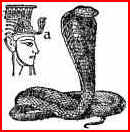 The cobra with spread hood appears as part of the uraeus, a golden band worn around the brow by Egyptian kings and queens as a sign of blessing upon the throne of the Pharoah. The cobra with spread hood appears as part of the uraeus, a golden band worn around the brow by Egyptian kings and queens as a sign of blessing upon the throne of the Pharoah.
Even after the Greek Ptolemies (including Cleopatra) 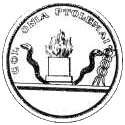 acquired that throne as a result of Roman political expedience, they kept the ancient 2-snake emblem. acquired that throne as a result of Roman political expedience, they kept the ancient 2-snake emblem.  This winged naga represents the life goddess, Buto or Uazet [Wadjet]. This winged naga represents the life goddess, Buto or Uazet [Wadjet].
She appears with her sister, goddess of the afterlife, on either side of the sun disc. With Nekhebet, more often depicted in her form as Vulture Goddess, the two form the  Ur-Uatchti. This emblem of Horus' victory over Set, the Adversary and Trickster god, appears as an amulet on temples. Ur-Uatchti. This emblem of Horus' victory over Set, the Adversary and Trickster god, appears as an amulet on temples. In the Tu'at or Underworld, one of the 4 deities associated with the 11th sector or 'hour,' is Nebt-khu. Snakes come forth daily from her feet and she lives upon their voices. Creator-Sustainer Enki [lord of stormy waters] lived with his mother Nammu [lady of abzu or sweet underground waters] in a cave in Sumer, ancient Mesopotamia. He was transformed into a flying serpent; that is, a dragon. Kingu is another Mesopotamian dragon-figure whose body was sacrificed by Marduk to form creation as a punishment for having fought on the side of Tiamat, the primeval chaos/mother also a serpentine being. The Romans brought from Syria, a goddess (Dea Syria) whom they called Artagatis. She is depicted as a woman in her 60's at attention, immobile as a tree, with a python balanced on its tail twined once around her, its head at her heart looking at her face. Rainbow and Cosmic Serpents In north Africa, a cosmic serpent named Minia is honoured. Her head is the sky and her tail is in the waters that are believed to lie under the earth. The Fon and Bantu peoples further to the south, believe that Mawu-Lisa formed the earth, and a creative power called Da Ayido Hwedo flows like a snake through creation. This serpent has held the earth together since that time. In Central Africa, Chinawezi, the Rainbow King plays a similar role. He is reminiscent of the cosmic serpent known as Shesha or Ananta [Endless] upon whose coils the Hindu creator, Vishnu, rests between cycles of creation. Olokun, ruler of the sea is a central African naga king who once attempted to conquer the earth by means of the Great Flood. The serpent also plays an important role as the creator of humankind. The Ashanti of Africa tell how the Creator Python come from the heavens and settled in the river. A couple from the heavens and a couple from the earth were introduced to each other, but neither pair could have children until the python sprayed them with water from his mouth, saying "Kus, Kus." This is what made them fertile, and able to populate the earth. In Mexico, it was believed that Quetzalcoatl, the feathered serpent, was one of the four gods to create humanity. With his twin, Xolotl, he went to the underworld to collect the bones of a man and woman who had died in earlier, unsuccessful creations. As he tried to escape the wrath of the Lord of the Underworld, he dropped some of the bones, shattering them. The Earth Goddess ground them up with some of Quetzalcoatl's own blood which restored them, and imbued them with life. In the Popul Vuh, the creation myth of the Quiche Maya [in Guatemala,] there also appear twin serpents with green feathers, male and female, called Xpiyacoc and Xmucane. The feathered, plumed or flying serpent unifies qualities of heaven with those of the earth. Indigenous people of Australia honour Almudj, the Rainbow Snake a.k.a. Warnayarra whose body parts are the features of the land. In fact, in many places the rainbow is thought of as a multi-coloured or brilliantly plumed serpent. It is this serpent that appears in conjunction with life-giving rain; the dry land comes alive with colour and the promise of plants for food. The Pitjantjatjara and Yankunytjatjara peoples of Central Australia tell about Kuniya (Woman Carpet-python) whose story appears on Uluru [Ayers Rock]. Her myth exemplifies their mythology, the Dreamtime or Tjukurpa. Immortality The snake seems to be able to come back to life. It lies dull and immobile for long periods, and then in a period of an hour or so, sloughs off its dry old skin to emerge from its hiding place shining with an opalescent gleam. The Greek word geras [cf. geriatrics] denotes the cast-off skin. Since the old skin may be sloughed off in one piece like an inside-out discarded glove, it can seem as if the old form has been left behind. This has been seen as evidence of the possibility of rebirth for other creatures, too. Barbara Walker points out that in Melanesia, the expression that is used to refer to the Christian concept of 'eternal life' is 'to slough one's skin'. In Italian there is the phrase 'older than a serpent', and that the Chinese image used to symbolize eternal life is an old man exchanging his skin for a new one. Sexuality The Pelasgian Great Goddess, Euronyme, danced with the Wind to produce Ophion who mated with Her to produce the World Egg. In the South-west of North America, the pregnant belly of the earth is thought by aboriginal people to be the site called Great Serpent Mound. The serpent is associated with sexuality only partly because of its obvious resemblance to the male organ of reproduction. Classical mythology recounts how the Tiresias, the prophet who had predicted the misfortunes of the family of Oedipus [who killed his father and went on, unknowingly to marry his mother, Jocasta], was himself a victim of the god's capriciousness. As a young man, Tiresias was going through the woods one day when he happened upon two snakes winding around each other in the process of copulating. He was startled and blindly struck both of them with his walking stick and instantaneously, he was transformed into a woman. He experienced life as a female for the next 7 years. In the 8th year, he came upon the two serpents once again. This time without emotion, he struck them intentionally. And was returned to his former state. However, he soon annoyed the Queen of Heaven, Juno [Gr.: Hera], by revealing to her husband Jove [Zeus] the fact that women derive more pleasure from the sexual act than men. He was cursed with blindness for the rest of his days. The actions of Tiresias are preserved in the form of the caduceus that Hermes [Latin: Mercury] carries as he leads the dead to the Underworld.  There are the two snakes twined around the moving staff. It should not be surprising to find that this emblem also embodies the twin channels as they wind up the chakras of the body with the spine the central rod terminates in the spherical head. There are the two snakes twined around the moving staff. It should not be surprising to find that this emblem also embodies the twin channels as they wind up the chakras of the body with the spine the central rod terminates in the spherical head. On the 3-sided blade of a Tibetan Buddhist phurba [pron. p'urba] sometimes referred to as a spirit dagger or spirit nail, we again see the pair of interwined snakes. Harmonia, wife of Cadmus (who slayed the dragon of Ares and founded Thebes) received as a wedding gift from Aphrodite, a special necklace. This Golden Necklace was in the form of an amphisbaina -- a two- headed serpent with open mouths clasping in their jaws a golden eagle, whose wings were decorated in yellow jasper and moonstone. Over many generations, the necklace (with an accompanying robe) was the source of terrible conflict. At Echmiadzin, the religious center of the Armenian Apostolic Church, there is a priest's staff decorated the heads of two serpents or dragons. There is also a type of Armenian carpet called vishapagor which depicts one or more serpents, or makes use of a serpent motif. ~ Anahit:Visit Armenia Outside certain Hindu temples, mainly in south India, small sculptures in various forms of serpents are set up at the foot of sacred trees. Many of these snake stones depict the familiar braided form of two copulating snakes which has come down to us as the emblem of the medical profession. These rupas [images] are offered in gratitude by couples whose wish for children, especially sons, has been granted by the deities to whom the snake | | |
|
Reply
 | |
Reply
 | | Perhaps the most common Pre-Christian symbol still in use today, is the round, whirling symbol of eternity. In Armenia it is found everywhere, in architecture; on doors, walls and on tombstones. It can also be found as part of various logotypes including the Dashnaktsutyun Party. Though it is said to mean eternity it also resembles the sun, and is probably connected to the ancient sun-worship, from which also the swastika and other sun-like symbols derive. Interestingly, the whirling symbol also bears some resemblance to cyclones or depictions of black holes in space. The earliest roots of round whirling sun-like symbols in the Armenian Highland are rock inscriptions from the Stone Age. 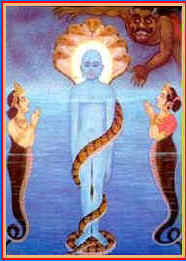
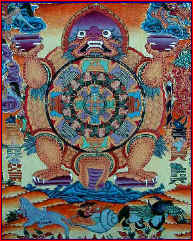
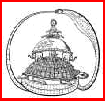
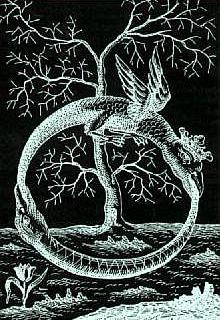
| | Reply
 | | The traditional Coat of Arms consisted of a shield or banner or varied forms, having the stylistic representation of a dragon Ñ a legendary and totemic animal of multiple symbolic significance. Also included on the Coat of Arms were the unicorn, tortoise and phoenix. Together, they make up the quartet of the traditional motifs and emblems of Viet Nam. The Dragon. The Dragon ("Long") is a fabulous beast which the Vietnamese mythology represents with the head of a camel, horns of a deer, eyes of a fish, ears of a buffalo, body and neck of a snake, scales of a carp, claws of an eagle, and feet of a tiger. A long barb hangs on each side of its mouth, and a precious stone shines brilliantly on its tongue. The summit of its head is decorated with a protuberance which is a sign of great intelligence. Finally, it has a crest of 81 scales running the entire length of its backbone. A dragon is said to breathe a kind of smoke which can be transformed at will into fire or water. It lives with equal ease in the sky, in the water, or underground. It is immortal and does not reproduce, because the number of dragons always increases with the metamorphosis of the ."Giao Long", which are fabulous reptilesÑhalf lizard and half snake Ñ that automatically become dragons after ten centuries of existence. Despite its awesome appearance, the dragon does not incarnate the spirit of evil, and the Vietnamese have always considered the dragon as a symbol of power and nobility. That is why the dragon was chosen as the special symbol of the emperors. The emperor was considered to be the son of Heaven. The dragon having five claws was found on the official dress of the emperor, and the dragon having four claws decorated the official dress of high dignitaries of the Royal Court. 
| | |
|
Reply
 | |
Reply
 | | Zaltys or the snake is also related to the World Tree. In this case, zaltys becomes a symbol of the life-force in vegetation and Mother Earth. The theme of woman, serpent and tree are seen in the Lithuanian myth of "Egle, Queen of Serpents", the Bible and other pagan myths. Alchemy and the Snake The serpent has long been associated with the practice of alchemy, an ancient specialization of European and Asian scholars. The objective was to discover a way to transmute base metals into gold, and to find the fabled elixir of immortality. Many contemporary researchers feel that the procedures described in alchemical texts were actually coded references to spiritual practices, rather than a form of elementary chemistry. 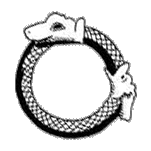 The endless serpent is one important image found in these alchemy books. It first appeared on a page in Kleopatra's book of the 10th century CE. In the space bounded by the snake holding its tail in its mouth was inscribed, "One is the All, and by it, the All, and in it, the All, and if it does not contain the All, then it is Nothing." The endless serpent is one important image found in these alchemy books. It first appeared on a page in Kleopatra's book of the 10th century CE. In the space bounded by the snake holding its tail in its mouth was inscribed, "One is the All, and by it, the All, and in it, the All, and if it does not contain the All, then it is Nothing."
This image, called the Ourobouros, appears also in the Codex Marciannus [Mark's reference is to alchemical procedures such as distillation, condensation, 'sublimation' and transformation. Kekule [1829-1896], the German chemist, had a lucid dream about Ourobouros (while on a bus, it is said!) that has often been referred to as the most "brilliant piece of prediction" in all organic chemistry. It revealed to him the long-sought carbon ring structure of the benzene molecule. The endless serpent signifies that all matter is basically interchangeable, and that forms are not absolute. In fact, we have in the Ourobouros the symbol for what is known in Buddhist philosophy as shunyata [Sanskrit] or Emptiness. The Codex explains that Ourobouros: - in its ensemble it is devoured, melted, dissolved and transformed by the process of putrefaction [decay]. It becomes a deep green, and the colour gold is derived from it. [Then] is derived the red called the colours of cinnabar.
- ... its head is deep green. Its four feet are the tetrasomei [4 base metals: copper, iron, lead and tin.] Its 3 ears are the sublime vapours: sulphur, mercury, orpiment.
- The One furnishes the Other in blood; the One gives birth to the Other. Nature rejoices in nature; nature triumphs over Nature ... .
- ... my dear friend, apply thy intelligence to these matters, and thou wilt not fall into error; but work seriously and without negligence, until thou hast seen the end of the Process ... .
- A serpent is stretched, guarding this temple, and he who has subdued it commences by sacrificing it, then roasts it, and after removing its flesh from its bones, make of it a step to the entrance of the temple. Mount upon it and thou shalt find the object sought. For the priest becomes at first a man of silver, a few days later, thou wilt find him changed into a man of gold.
The student of tantric yoga will surely recognize these references ~ alchemy is not solely about transforming what is outside us. | | Reply
 | | Dangers & Drawbacks of Tantric Practice if unprepared -
Without Refuge in the Three Gems you are "on your own." -
Without a guru it is as if you are walking in the dark -
Without the empowerment or initiation is as if you have no map -
Without devotion or faith, there cannot be whole-hearted commitment to the task -
Without purification, neurotic tendencies such as feelings of unworthiness or pride, and so on, stand in the way of accomplishment. -
Without generosity, you might think it is possible to accrue personal merit. -
Without awareness of Emptiness, you could easily end up falling into superstition, worshiping idols, and ending up in a far worse position than before. | | Reply
 | | Réponse
 | | </NOINDEX> seraph , plural seraphim<NOINDEX> [–im] </NOINDEX>, supernatural being. The name seems to derive from the Hebrew word “to burn.�?According to the Book of Isaiah, seraphim have six wings. Scholars have suggested that seraphim were winged serpents. In Numbers, the word “seraph�?denotes a “fiery�?(i.e. poisonous) serpent. Like cherubim, seraphim are associated with the glory of God, as in the liturgy. See also cherub. | | Réponse
 | | </NOINDEX> Apis , in Egyptian religion, sacred bull of Memphis, said to be the incarnation of Osiris or of Ptah. His worship spread throughout the Mediterranean world and was particularly important during the time of the Roman Empire. See also Serapis. Serapis or Sarapis<NOINDEX> [särä'pis] </NOINDEX>, Egyptian god whose devotees united the worship of the Apis bull and the god Osiris. His cult, which originated at Memphis, rose to its greatest significance at Alexandria during the reign of Ptolemy I. He was adopted as the universal godhead by some Gnostic sects. In Greece during Hellenistic times and later during the Roman Empire his worship rivaled that of other Middle Eastern and Mediterranean cults. | | | | Reply
 | | MIDGARD SERPENT The great snake which lies in the ocean and encircles the world, its tail in its mouth. On the day of Ragnarok, the world will disappear under the ocean's waters when the Midgard Serpent rises from the sea. Thor will kill the Midgard Serpent but will be killed by the Serpent's poison. In "The Prose Edda" of Snori Sturlason, a compendium of Norse pagan myths written in 1220 A.D., Thor, the Norse god of thunder, twice encounters a creature known as Jormungander, the "World Serpent," also known as the Midgard Serpent. Jormungander was said to be one of three offspring of the trickster-god Loki and the giantess Angrboda, and so prodigious was the size of their monstrous, aquatic child that it coiled about the entirety of the world. Thor first encounters Jormungander in the company of the giant Hymir, whom Thor press-gangs into service as a rower in an attempt to capture Jormungander. Taking the severed head of Hymir's favorite ox Himinbrjotr, "Sky Bellower," as bait for the serpent, Thor and the giant row out into the sea. Thor ties a long line to a hook he has fashioned, impales the ox-head with it and lowers the bait to the bottom of the sea. The narrative continues, per Sturlason: "The Midgard Serpent snapped at the ox-head, and the hook caught in its jaw; but when the Serpent was aware of this, it dashed away so fiercely that both Thor's fists crashed against the gunwale. Then Thor was angered, and took upon him his divine strength, braced his feet so strongly that he plunged through the ship with both feet, and dashed his feet against the bottom; then he drew the Serpent up to the gunwale. And it may be said that no one has seen very fearful sights who might not see that: how Thor flashed fiery glances at the Serpent, and the Serpent in turn stared up toward him from below and blew venom." (Sturlason, The Prose Edda, Brodeur translation) Then, just as Thor is about to dispatch the beast with his hammer, Hymir, scared out of his wits (and probably more than a little resentful about the loss of his ox) severs the line, whereupon the serpent disappears below the waves. Thor's second, final encounter with Jormungander comes at the time of Ragnarok, the incineration of the world that prefigures the rebirth of man; Thor and Jormungander fight to the death, Jormungander by hammer-blow and Thor by the venomous secretions of the serpent. 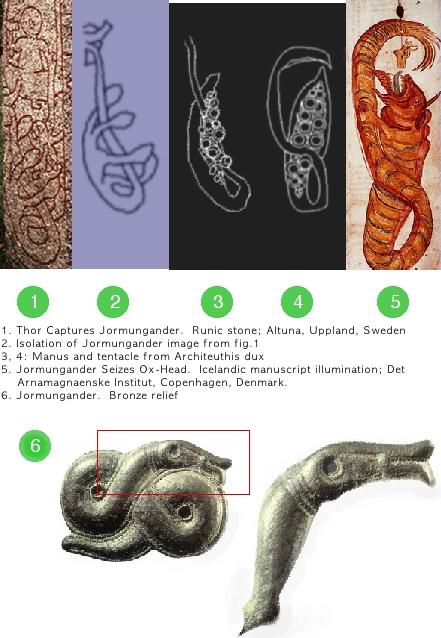 Visual representations of the Midgard serpent typically present a long, sinuous creature that coils upon itself, sometimes as a hooped serpent with it's tail in it's mouth, and at others as a kind of living Mobius strip. One of the more famous images appears on a carved granite obelisk in Altuna, Sweden. Colored with iron oxide-pigment, the Runic carving depicts Thor hauling a writhing Jormungander to the surface (Fig.1). Within a nest of heads on slender necks, the beast grasps the tethered head of Sky-Bellower. An isolation of the Jormungander element (Fig. 2) gives us an idea of the thing's general planform. | | |
|
Reply
 | |
Reply
 | | Serpent Gnosticism, Apostasy Of All Ages
Source Of The Female Priestess and Woman Preacher Movement In Babylon, after the flood, a mystery religion was created by Nimrod and his wife Semiramis. At its core, was a sexual interpretation of the serpent and the fall of Adam and Eve. It became known as the "secret mystery, the Chaldean mysteries, or the secret knowledge religion." This religion was the adversary and antagonist of the Old Testament Saints and Prophets. From the time of Alexander the Great, the religion of Babylon changed names from worship of Baal, and became known around the Mediterranean coastal nations as "Gnosticism". Those who believed and practiced this Babel religion were called Gnostics. Those who did not believe it were considered agnostics. The word "agnostic" means "a" = no or not, and "Gnostic" = knowledge. Combining the two, the word "agnostic" means "no knowledge or not believing the secret knowledge;" and later interpreted to mean: "not having knowledge because of ignorance." The idea of the word "agnostic" meaning a person is ignorant of a fact or facts that would cause one to "believe" in the true God, is a later adaptation and application. The word "agnostic" is used today of those who claim not to have a fact or facts upon which to base a solid belief in GOD. This indicates they are confessing that certain categories of their intellect remains ignorant. Fact is, they willfully desire "NO KNOWLEDGE" of GOD. Anciently however, you may see that among the religion of the "Gnostics," the word "agnostic," would have identified a person who desired not to believe, or who desired to remain ignorant of the secret rituals through which the Gnostic "good-god", the serpent, and the mystery religion of Babel, might be exposed or revealed. The Gnostic mystery religion of Babylon worshiped Eve in the female sex as the benefactor of Man. She was worshiped and venerated as a whore goddess, often nude, and known after Babel among other languages as: Ishtar, Ashtoreth, Nuit=(Tanuit, Anuit), Hathor, Isis, Aphrodites, Diana, Cybele, Demeter, Ceres, Venus, Athena, Varuna, et al.). The serpent as the "good-god" was worshiped as having infused the woman with his passion and lust, to use her body to the pleasure of herself and those whom she wanted to dominate. Adam was worshiped in the person of Nimrod and Baal as the consort of his whore wife who was also called an "asherah." The true GOD was envisioned as a wrathful Deity of hate, who was guilty of opposing this "CHOICE" of use by Eve and all females, with their body. The woman became the high-priestess of the Gnostic religion through sexual ordination. Because she gives birth, she was also venerated as the great mother and came to be worshiped as "mother earth" who brings to birth all things. The environmental movement today, is therefore a Gnostic revival of mystery Babylon. Through it, paganism has emerged and revived. The antichrist New World Order is replacing Communism with a new brand of Gnosticism identified as pantheist-environmentalism. This religion worships mother earth and its members proudly slander Jesus Messiah and Christian sexual morals. Those championing the environmental revival, are generally members of various other aggressive Gnostic cults, or GODless religions. Look! And you will see the WOMEN PRIESTESS leading in the new Gnostic revival. These same people are the ones leading the fight for abortion; homosexuality and lesbianism; pornography; sex films, movies, and video tapes; nudity; live-and-let-live philosophy; don't judge me theology; holiness of sin doctrine; and feminized control of everything, including the pulpit. The gnosis religion of Babylon was called Mystery, because it contained "secret knowledge" disclosed only through: "blood-oaths, oaths of allegiance, swearing of oaths, secret handshakes, signs, signals, symbols, images, pass-words, sexual rituals, and meanings of coded riddles." This secret knowledge is alleged to be identical to that "gnosis-knowledge" taught to Eve by the serpent. In its final analysis, the serpent is the "good-god" and Eve is the whore goddess and high-priestess. This cult is also identical to the "SOPHIA" religion. "Sophia" means "wisdom." Hence, they believed in "secret wisdom" known only among initiates who were sexually reprobated to become members. One branch of Gnostics saw in Jesus Messiah, the dispenser of knowledge of the Kingdom of God, a similarity to their pagan beliefs of the serpent. Thus two Gnostic "christian" sects called the Naasenes (Hebrew nahas, snake) Ophites (Greek ophis, snake), worshiped the serpent in the alleged identity of Jesus Messiah. They stole the symbol of the cross and entwined the serpent around it. This is no doubt Paul's reference of: "They changed the Truth into a lie (Rom. 1:25)." Since satan is identified as the first "liar", we may paraphrase Paul's statement as: "The Gnostics changed the Truth about God-Jesus and made him to become the serpent." Is this Paul's way of exposing the Gnostics whom he withstood? Looking at Gnosticism through the windows of the Old Testament, the altars of Baal and Ashtoreth represented the religion of the serpent Gnostics in Israel. The Old Testament saints had a choice. They could follow the knowledge and ways of GOD, or follow the knowledge (gnosis) and ways of the "good-god," the serpent. It was a choice of Baal or God. Now you know the REST OF THE STORY! This religion was very much alive in the days of the Apostles. It was scattered throughout all nations. Even in Israel, the Gnostic religion thrived well in Hellenism. It polluted many early Christian congregations like William Branham's serpent seed doctrine of our day. The Gnostics used women priestess who would teach man the secret knowledge. Because sex was a part of the Babylonian ritual, it was taught by the Gnostics, that Eve had sex with the serpent and Cain was the serpent's seed. The Gnostics taught that Cain was the good seed and that is why he was not to be killed for the murder of Abel, whom the Gnostics taught was not a true brother of Cain. Abel was seen as a child born by the power of the bad GOD who had cursed Adam and Eve during a temper tantrum and drove them from paradise. For the Apostles to have ordained women to teach, preach, be a messenger, or have a part in the Five-Fold-Ministry, would have identified them as party and part of the Gnostic religion of Babel. There was a 4,000 year period when a woman of GOD did not build altars, did not offer her own sacrifices, did not act as a mediator, did not act as a messenger or teacher of spiritual matters of redemption or salvation, did not use her body in a sexually immoral way as hire or a tool of making converts. Surely, God foreseen Babel and serpent Gnosticism and set in motion a male dominated Priesthood to guard females for the next 6,000 years of continued attempt by the serpent to deceive and lead them astray into the deeper apostasy of witchcraft, channeling, demon control, astrology, and lesbianism. True women of Faith were prohibited from going to these shrines of debauchery, high places of whoredom, or chasing after becoming a priestess or high-priestess at these pagan altars, and there is no mystery why. The patriarchs and Prophets withstood Babel Gnosticism. When God told Terah to get his family out of Ur of the Chaldees, it was precisely to separate them away from Babylonian Gnosticism, to walk in a new life which would be revealed to him. What message should this speak to us today about Gnosticism? Abraham rejected Gnosticism and choosing God, his journey was called the way of "FAITH"! The word "Hebrew" which means from "the other side," identifies Abraham's religion not his race stock. It is the name of the religious standard lived by the Patriarchs on "the other side" of the flood and before the great deluge. GOD codified the revelations of the righteous, from Adam to Noah, and although Abraham was a Syrian Gentile by blood stock, he was a Hebrew by this religion. It is written that Abraham believed GOD (in opposition to Gnosticism) and it was counted unto him for righteousness. All those of this "HEBREW FAITH" are of the Covenant of Abraham. The true Hebrews are manifested followers of Jesus Messiah (Gal. 3:7,8,9,14,16,29)! All those outside of this faith, are not counted as "Hebrews" or righteous through Jesus Messiah. The HEBREW FAITH of Abraham and the HEBREW FAITH of Jesus Messiah are identical. The Law of Moses, IS NOT the Hebrew Faith! The Gnostics were the enemy of the Patriarchs and the adversaries of the Old Testament saints and Prophets. They were the persecutors and murderers of John the Baptist, Jesus Messiah, the Apostles, members of the Five-Fold-Ministry, and members of the New Testament Church. Behind this enmity was the spirit of the serpent, the enemy of all ages. It is no secret that the entire life of Jesus Messiah was openly against satan, his Gnostic representatives, and their kingdoms, which the devil promised him if he would bow down and worship at his hoofs. The power of Gnosticism was great over the hearts and souls of Israel. This battle did not abate during the life of the Apostles. Simeon the sorcerer was a Gnostic. Everywhere the Gospel was preached, the Jewish and Gentile Gnostics were the chief persecutors of the Christian faith. The two hundred years of Israel, before Messiah, was dominated by Gnosticism as modified to Jewish mystics in Babylon. Philo adapted the Old Testament to Babylonian mysticism and birthed many of the secrets of the Cabala (hidden secrets) otherwise called by some sources as the "oral secret law". The Catholic Church was created out of the mixture of Babylonian mysticism, Judean Cabalism, and the pre-nicean Gnostics adaptations to Christianity. Thus, Catholicism and all of Protestantism has Gnosticism for its doctrine and the serpent as their "god" of light. They have polluted the Apostolic Truth, corrupted the Apostolic record, formulated non-Christian meaningless rituals, and created false plans of salvation. They have rejected the true doctrines of Jesus Messiah and his Apostles. There can be no concord with Messiah and Belial, (the serpent or a person possessed with his spirit), the god of Gnosticism. There were sons and daughters of Belial:
-
"Certain men, the children of Belial, (adherents of the serpent's Gnostic religion) are gone out from among you, and have withdrawn the inhabitants of their city, saying, Let us go and serve other gods (of Babylon), which ye have not known (Deut. 13:13)."
-
"Count not thine handmaid for a daughter of Belial (the serpent's religion): for out of the abundance of my complaint and grief have I spoken hitherto (1Sam. 1:16)." In this last verse, Hannah begs to confess, that she is not one of the Gnostics of her day, identified as a drunken cheap whore of the daughters of Belial. How very precious! A book HIGHLY recommended and worth reading, that exposes the Gnostic religion in a nut shell, is entitled: "THE GNOSTIC EMPIRE STRIKES BACK." by Peter Jones. The false doctrine of the serpent religion is Mystery Babylon, and it is the enemy of the Church today. Women preachers were established in Babylon and in the Gnostic religion of the serpent. For that reason and many more, they have always been rejected among the "faith" of the true people of GOD. A woman preacher, by her usurping that office, is a Gnostic, not a member of the Five-Fold-Ministry. Good intentions not according to sound doctrine is still sin. If a woman has done this unknowingly, she will renounce her error and quit. The serpent could easily have spoken to Adam as he did to Eve, how come he didn't? A Scriptural possibility is that the serpent observed until he found the "weaker" of the two. He preyed upon the "weakness" of Eve and avoided the strength of Adam. From the time of Eden, women were thereafter identified as the "weaker vessel":
-
"Likewise, ye husbands, dwell with them according to knowledge, giving honour unto the wife, as unto the weaker vessel, and as being heirs together of the grace of life; that your prayers be not hindered (1Pet. 3:7)." Apostle Peter placed all women in the category of the "weaker vessel" and thus revealed that they need the guard of the husband or in his absence, a Pastor of a Church. If the husband takes his Biblical role as guard and the weaker vessel submits to his headship, three things immediately happen. #1) Peter said the husband was to give his wife honor. #2) They would be heirs together of the grace of life. #3) Their prayers would not be hindered. The Church of Jesus Messiah defeats Gnosticism with the simple doctrines of love, family, headship, morality, and holiness. Our search among the true Apostolic Woman will not reveal a single Gnostic. They will reject the Babylonian mystery of iniquity and stay out of the pulpit. | | |
|
Reply
 | |
Reply
 | | AFRICA:
Santeria-Macumba Abacua-Candomble Palo Mayombe-Umbanda Art Gallery (Santeria-Macumba)
Voodoo-Hoodoo Condemnations Egyptians Art Gallery of Santeria-Macumba-Egypt
Art Gallery of the Occult
Glossary of the Occult
Religions Art Gallery Africa is a big place, with 51 independent countries today, and hundreds of independent tribes before... and each one has its own way to practice religion!.. Inhabited by two major groups: The "Caucasoid", in North Africa, Egypt and Sudan, with brown eyes, light olive kin, and high- bridged narrow noses. And the "Black", in the rest of Africa. Some, notably the Tutsy are very tall in east central Africa. The Pygmies are one of the shortest people in the world, in tropical central Africa. In tropical Africa alone some 1,000 different languages are spoken... and in each language there are many tribes and religious systems. Arabic is predominant in northern Africa. Berber is also spoken in in northern Africa. Bantu languages are spoken throughout central and eastern Africa. Zulu is a Bantu language spoken in South Africa. Sudanic is spoken in the large grassland region south of the Sahara. Hausa spoken in western Africa... and on top of it, many countries, after their independence, kept as official also a European language: French, English, Portuguese, Spanish, German, Dutch... In South Africa, the Afrikaan is a German language derived from 17th century Dutch Their "primitive religions" are based on nature worship, and may have in common the 3 kind of occultism: Divination, witchcraft (magic) and spiritism, with the "sacrifice" of animals, and sometimes of humans, to calm the gods-demons; and reverence for the "ancestors"... often, the head of the tribe, or the Pharos, is "the god", though in each tribe there may be many "gods-demons"... See Animism. In general, they have two kinds of diviners: The isangoma of the Zulu, is a medium who can make contact with the ancestral spirits and prescribe medicines according to their dictates. And the isanus, also in the Zulu, is a diviner capable of "smelling out" sorceress and other evil-doers. The herbalists, inyanga yokewlapha in the Zulu, have the tasks, still today, to administer medicines made from plants and animals. The Muslims in the North, and the Christians in the South of the Sahara Desert, have changed most of African religion... but it is estimated that more than 40% of Africans still practice "animism", often in syncretism with their new Christian or Muslim religions. I just came from South Africa and I was impressed with their National Anthem which starts with the words Lord have mercy on Africa... it is like a Psalm!... and I had the opportunity to experience the simple and glorious natural life of some of the cultures of the Zulu, Shosa, Ndebele, Venda, Tsonga, Basotho, Tswana, Pedi, Ntwana, San... and though they are vanishing cultures, there is much to learn from them: Their respect to their chiefs, parents and ancestors, their simple industrious life, their joy in celebrating anything with beautiful songs and dances lived in a fraternal community... 1- "Santeria" and "Macumba" (from Nigeria): See Art Gallery-Santeria In Nigeria, the Ju-Ju tribe of the Yoruba culture has a religion with 600 gods who are demons, because the "false gods" are "demons" (Psa. 96:5). They came to Cuba and Brazil with the slaves. From Cuba, with the name "Santeria", they came to Miami, New York... only in Miami there are 20,000 santero-priests (babalaos). In Brazil its name is "Macumba" (sanctuary), and only in Rio de Janeiro there are 65,000 temples, with 40 million Brazilians combining Christian beliefs with Spirit worship. Both in Cuba and Brazil 25 gods-demons were given the names of "Catholic Saints", therefore, the new name "Santeria" in Spanish, or "Macumba" (sanctuary), in Portuguese. The supreme deity, and the father of all the gods, is "Olurun", represented by Jesus Christ on the cross. But the 3 most popular are "Obatalá" (O.L. of Mercy"); "Changó" (St. Barbara); and "Ochún" (Virgin of Charity)... but these gods are no God, they practice adultery, homosexuality, incest, they hate and fight each other... for example, "Yemayá" (Virgin of Regla), had 14 children in incest-impossible relations with her son "Orungán" (Baby Jesus)... there are "gods-demons"!... demons!... (Psalm 96:5) To become a "santero" it may cost $10,000, with the right to use the "snail shells" for divination or magic, charging about $500 for each work of magic; those who do not have the $10,000, can became "smaller santeros", but they only can use "coconuts" for their divination or magic. To become a "santero-priest", a "babalao", is more expensive, but he has the right to offer "sacrifices of animals" for magic. It is "condemned by the Bible", with very strong words "abominations to God", "stone them to death" (Deut.18, Lev.20)... for 3 reasons: 1- Because it is a "polytheistic religion". There is only one God, and any other god is a demon (Psalm 96:5). 2- For the practice of "occultism". They actually use the three kinds of Occultism!. 3- For the "sacrilege" of using Christian Saints to mask their god-demons, creating confusion among many ignorant believers. The Church also condemns them very strongly: You can't go to the santero and then to communion; you can not receive communion with the medal of St. Barbara or a Santeria collar... they are "very grave sins", "prostitution against God". Please, take off the medal of St. Barbara, it is not the Catholic Saint, but the devil Changó; do not use the "Santeria collars", because you are inviting devils into your life; St. Lazarus, is not the Catholic Saint, but the demon Babalu-Aye... 2- "Abacua" and "Candomble" (from Nigeria): Also from Nigeria came the "Abacua" to Cuba, and the "Candomble" to Brazil, mainly to the Bahia area. They are worse than the Santeria, using mainly "black magic", to take vengeance, to injury or even to kill an enemy. They may offer to the gods "humans", instead of animal sacrifices. 3- "Palo Mayombe", "Umbanda" (from Congo): Both came from the bantues tribes of Congo; "Palo Mayombe" to Cuba, and "Umbanda" to Brazil... They are the worse!... they use black magic to destroy or kill an enemy... instead of the snail shells used by the santeros, the "paleros" use the "kettle", the "nganga", a boiler, where they put rests of a human cadaver recently death, plus the cadaver of a black dog, and scorpions, worms, plants... and they introduce in it 28 "palos" (sticks), the basis of their black magic. See Art Gallery (Santeria) 4- "Voodoo" and "Hoodoo" (from Begin): From the kingdom of Dahomy, in the present country of Begin, the "Voodoo" or "Vadium" came to Haiti, and from Haiti to New Orleans and Mississippi, with the name of "Hoodoo". It is the religion of the "serpent", the supreme god-devil, "Dambalah"... and the "Great Zombi". The priest, Queen or King, Mama or Papa, is mostly a woman, the "mambo"... and their feasts end up in a naked orgy, adoring the serpent, with the use of stimulant and aphrodisiac incenses, plus the drinking of drugs, mainly "tafia"... In New Orleans is very private, with many government regulations... but in Haiti they have a "tour" to bring you to a real Woodoo session... and you are going to get it, the "power", the "gris-gris", with the odor and smoke of the incense, even if you don't drink any tafia... you may "become like a zombi" for 3 weeks, with a terrible headache for over a year, as one of my patients... Egyptian Religion: See Art Gallery (Egyptian Gods) Is the religion of an afterlife, with the pyramids of the gods-pharaohs, and the tombs of the mummified bulls... besides the bull, the Egyptians worshiped the falcons, cats, jackals, crocodiles... Their gods are based on the forces of nature, and they have over 50 gods-devils, who are no God... they fight each other, are jealous, and the most loved, Osiris and Isis, were brothers and husband and wife. The chief god was "Ra", the sun god, to whom all obelisks are dedicated; the pharaohs were reincarnation of Horus, the son of Osiris and Isis, the forerunner of Venus in Rome. The "Book of the Dead" and the "Wisdom Literature" are good codices of moral ethics... the one who does good, goes to eternal happiness; the bad ones are destroyed by Seth, the evil one. HOME | Copyright © 1998 E-Mail to: Dr. Domínguez | | Last update: Friday, June 18, 1999 | | | |
|
Reply
 | |
Nu Kua or Nu Hua-shi 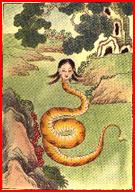 The Creator-goddess of ancient China, Neu-kwa [Nu Kua or Nu Gua], is here depicted like Echidna, of Greek mythology, with only the head of a woman. However, she is usually described as having the upper body of a woman that melts into her serpent lower-half. After creation, during which she made humans, she put down a rebellion against heavenly order. When the dying rebel chief shook the heavenly pillars, she restored the sky by melting turquoises. The Creator-goddess of ancient China, Neu-kwa [Nu Kua or Nu Gua], is here depicted like Echidna, of Greek mythology, with only the head of a woman. However, she is usually described as having the upper body of a woman that melts into her serpent lower-half. After creation, during which she made humans, she put down a rebellion against heavenly order. When the dying rebel chief shook the heavenly pillars, she restored the sky by melting turquoises.
Nu Huashi also used the toes of the cosmic tortoise (Kashyapa, of Indian mythology) as markers for the compass' directions. She restored the land at the time of the Flood with the ash from burnt reeds. Since she is credited with establishing the custom of marriage, she is considered the source of human order, too (like the Egyptian Ma'at.) The queen of all nagas, she combines and embodies creativity, cosmic order, water, earth and sky. |
|
Reply
 | |
The winged naga links sky, earth and water.  This is Uazet or Wadjet, the ancient Egyptian form. This is Uazet or Wadjet, the ancient Egyptian form.
|
|
Reply
 | |
In Buddhism A well-known Theravada sutra turning around the device of Buddha's giving advice to Rahula his son, is called the Chapter of the Snake [Uragavagga] It is the first chapter of the Sutta-Nipata [Collection of Discourses]. Its title comes from the name of the first section, Uraga Sutta [On the Snake’s Skin] that is about the monk who discards all human passions and is then compared to a snake that has shed its skin. Nagarjuna, in his teaching on the Prajnaparamita,refers to the dehumanizing effects of poverty. He reminds us of the three friends that lived happily together in a pool -- a snake, a turtle and a frog. When the water dried up, the snake (who had been Devadatta, the Buddha's nemesis, in a former lifetime) asks the turtle to send for the frog. However, the frog is wise to the snake's motivation and does not go, and he tells Turtle the reason: - Encountering poverty and destitution,
- One loses one's firmest fine resolution.
- We forget our principles,
- Thinking of victuals.
|
|
Reply
 | |
Indian mythology tells how Vasuki the eldest son of Kashyapa, ancient Tortoise-father who is the earth's foundation and Kadru ancient Garuda-mother served as the rope (Mount Mandara or Meru served as the paddle) by which the gods churned the Milky Ocean at the beginning of time to get amrita. 
|
| |
 First First
 Previous
2-14 of 14
Next Previous
2-14 of 14
Next Last
Last
|
|
|
 Free Forum Hosting
Free Forum Hosting